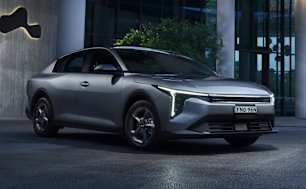The K4 feels big for the class, especially compared to its nearest rivals and that translates to a cabin that feels adult-friendly in both rows. An impressive feat for a small sedan.
Access is the only time you will have moments of 'I should have opted for an SUV'. That's because you will get in your daily squats sliding in and out of the K4 due to its 140mm ground clearance.
The rear doors also feature a wide wing that juts out from the door handle and it catches your hip almost every time you go to close the door.
The wide front seats offer lots of comfort with thick padding and long under-thigh-support. The driver's side is powered with adjustable lumbar support but the passenger seat only offers manual adjustments, which is surprising for a top-grade model. However, both front seats enjoy heat and ventilation functions.
The back bench seat offers similar comfort to the front with seat padding and length but it's not terribly wide and two adults (or child car seats) will fit best.
Amenities and storage is decent for the class with each row enjoying four drink holders and two USB-C ports. Front rowers also get a wireless charging pad and 12-volt socket.
In the front there is a large glove box that fits more than just an owner's manual, a mid-size middle console and a centre console that features retractable cupholders to open up the space if you need to. A dedicated phone cradle with small spaces on each side rounds up individual storage for the front.
In the rear there are two map pockets, a small item cubby next to the USB-C ports and a pair of directional air vents, reading lights and a fold-down armrest.
The boot space is massive for the class at 508L (that's nearing mid-size SUV territory) but the aperture is narrow and I couldn't fit my big booster seat through the opening.
The boot is quite deep as well and you may find yourself climbing into it to retrieve items that roll into the back.
The rear bench seat has a 60/40 split which can help with storage and there is a temporary spare tyre underneath the floor.
While you don't get a powered tailgate in this model, the lid isn't heavy to operate and has a proximity opening function that keeps it practical when you have your hands full.
This just means when you approach and stay near the boot with the key fob on your person the boot lid will pop open for you.
The 12.3-inch touchscreen multimedia system looks great with crisp graphics and a responsive touchscreen. The menus are in an easy-to-understand layout which you'll get accustomed to in no time. The 5.0-inch climate display sits to the right of this system and it's nice to have it on display all the time.
The 12.3-inch digital instrument cluster isn't all that customisable but it's easy to read with large text and a small menu screen that shows nav directions, trip info or a compass.
The built-in satellite navigation system is easy to get going and to cancel a route guidance, it's a one button affair which is great for when you're on the go.
The system features wired and wireless Apple CarPlay and Android Auto. The CarPlay is simple to connect to and retained a steady connection this week with feedback from my callers that my voice was clear on calls.

